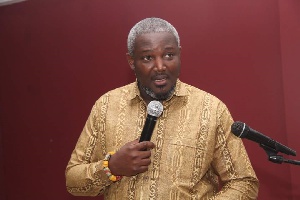Mr John Mahama, as president, commissioned the University of Ghana Medical Centre in early 2016 for electoral gain, although the facility was not yet ready for use, Deputy Minister of Information Perry Okudzeto has said.
The Medical Centre is an ultra-modern facility for service delivery, training and research. It is equipped with state-of-the-art facilities for trauma and emergency services with a heliport and internal medicine, including surgery, obstetrics and gynaecology, paediatrics, cardiology, heart surgery and medicinal imaging. Construction of the facility started on 12 March 2011, with a sod-cutting ceremony by then-president Professor John Evans Atta Mills.
In June 2011, Cabinet gave approval for a loan facility from Israel for the design, construction, and installation of medical equipment for the Centre.
The Phase I was expected to have 650 beds and Phase 2 adding 350 beds to increase the total number of beds to 1000.
The project, which is located on a 400-acre land behind Noguchi Memorial Institute for Medical Research, cost $217 million but has been idle since Mr Mahama opened it for use.
Recent agitations by campaigners who are pushing for it to be opened for use, compelled the government to issue a statement saying the facility will be operational between now and July.
Explaining the delay in its use to Moro Awudu on Class91.3FM’s Executive Breakfast Show on Friday, 1 June, Mr Okudzeto said: “A hospital is not just a concrete structure or some facilities, a hospital includes, yes, a concrete structure, facilities, management, staff; all of this mix must come to play in order for a hospital to run smoothly, especially when we have, as a nation, and, as an entity, which is the UG, collaborated in taking loans on behalf of the people of Ghana, expended to make sure that we bring quality health care to our people and we know that this hospital serves a dual purpose – a hospital and a teaching hospital at the same time – so, there needs to be some efforts to make sure that whatever is needed to operationalise the hospital is done. Then there have been some issues about the special purpose vehicle that was put together under the NDC to manage the hospital.”
Mr Okudzeto pointed out that: “One thing we must admit is that the hospital, when it was commissioned was not ready to operate, yet it was commissioned. There was still some work that needed to be done, and that is what has been done over the period and some finishing being put to it and that’s why government says that we have taken cognisance of the sentiments that have been expressed out there in the public, we are working to make sure that the hospital opens”.
He stressed: “The facility was not ready as of the time it was commissioned, it was commissioned based on the expediency of an election”.
Beyond that, he added: “The issue is that this a state-of-the-art teaching hospital with equipment that need a certain level of constant power supply, the discussions have been that a sub-station be put together so that it can assure a constant supply of power so that there are no fluctuations in order not to destroy the equipment that we’ve invested millions of dollars into. That was not done before the project was commissioned”.
With immediate effect, Mr Okudzeto noted, “A team is working so that between now and July, the hospital is opened to the public, putting finishing touches to the recruitment process and making sure that people are trained to go and do their work, making sure that the facilities that have been provided and already available, the testing is finished; making sure that additional facilities that are supposed to be installed are installed, putting a reliable power supply project in place. Yes people have talked about the fact that there are generators in the hospital, and, therefore, the power supply issues that have been raised are not tenable. The issue is that this is a huge facility, it needs and constant and a reliable supply of power that is why if you read the statement, it says that government has secured funds for a Phase II part of the project. That Phase II part includes the construction of a sub-station that will assure us of constant supply of power to the facility”.
General News of Friday, 1 June 2018
Source: asempafmonline.com

















